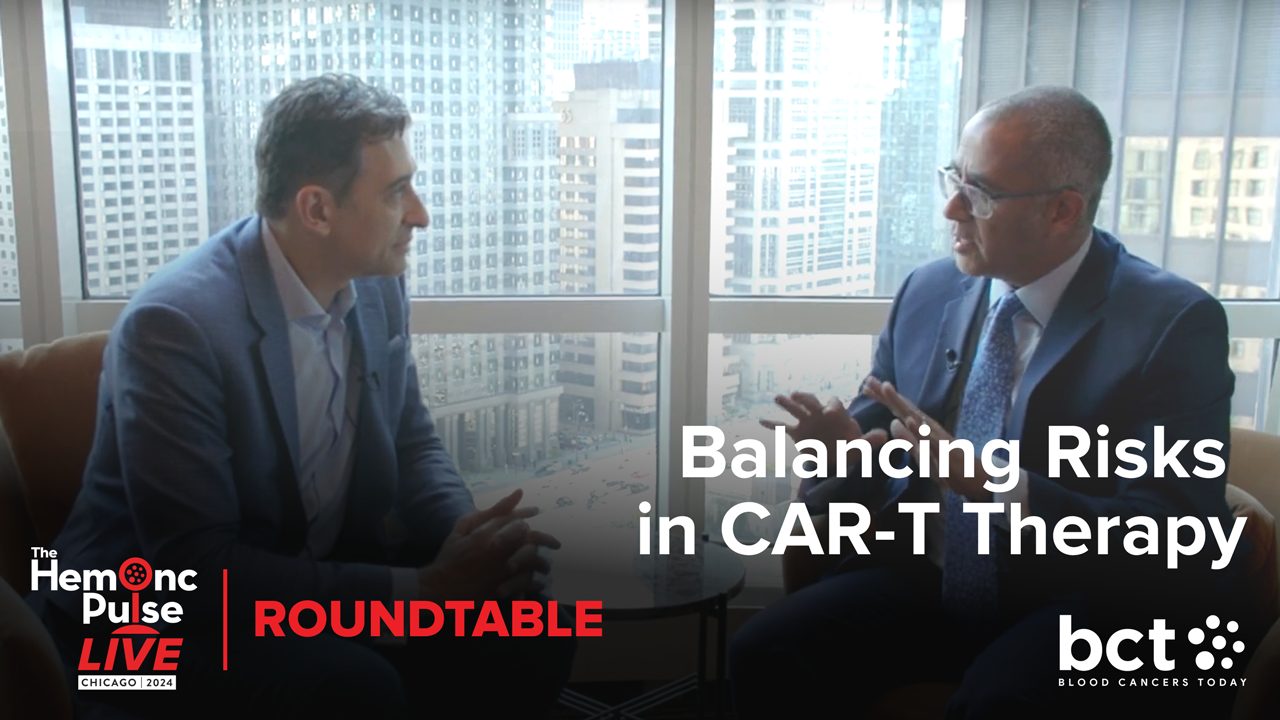What Drives Frontline Treatment Decisions in Patients With Myelofibrosis?
By Ruben Mesa, MD, Naveen Pemmaraju, MD, Sanam Loghavi, MD, Olatoyosi Odenike, MD - Last Updated: June 7, 2024A roundtable discussion, moderated by Ruben Mesa, MD, of the Atrium Health Wake Forest Baptist Comprehensive Cancer Center, focused on the latest updates in myeloproliferative neoplasms. Dr. Mesa was joined by Naveen Pemmaraju, MD, of the University of Texas MD Anderson Cancer Center; Sanam Loghavi, MD, of the MD Anderson Cancer Center; and Olatoyosi Odenike, MD, of the University of Chicago Medicine.
In the fourth segment of the roundtable series, the panel discusses frontline ruxolitinib treatment for myelofibrosis.
—
Dr. Mesa: In 2024, we have four Janus kinase (JAK) inhibitors approved by the US Food and Drug Association: ruxolitinib, fedratinib, pacritinib, and momelotinib. What factors drive clinical decisions regarding treating patients with ruxolitinib in the frontline setting?
Dr. Odenike: For me, a ruxolitinib patient has splenomegaly, constitutional symptoms, and relatively well-preserved hematopoiesis. With ruxolitinib therapy, we can expect a drop in hemoglobin in the range of 1.5-2.0 grams around the six-to-eight-week mark. If somebody walks into my clinic and is already significantly anemic and teetering on the verge of needing blood transfusions, I don’t instinctively reach for ruxolitinib. If somebody comes in with hemoglobin levels of 11 or 12 grams, but their spleen is big and they’re losing weight, that’s the perfect patient for ruxolitinib therapy.
Dr. Pemmaraju: I agree with everything you said. It comes down to the cytopenias and blood counts. If platelets are below 50, I’m reaching for the newer agents, including pacritinib. Traditionally, we didn’t necessarily use anemia as a marker because we only had the ruxolitinib agent. If someone has severe anemia or thrombocytopenia, that’s the patient I’m not selecting ruxolitinib for in the frontline setting.
Dr. Mesa: I would add that everyone’s fair game for ruxolitinib who doesn’t have severe cytopenias. However, the group that is the biggest slam dunk is post polycythemia vera (PV) and JAK2-mutated patients. In that group, we’ve seen bigger spleen, more symptoms, and higher counts. Post-PV/MF patients aren’t as anemic, because they still preserve some intrinsic erythrocytosis that’s fighting to get out there. That’s always been the group that thrives in that setting.
We now have more than a decade of experience with follow-up bone marrow on patients who have been on ruxolitinib. Are there any signs from the marrow that you would correlate with response or lack of response?
Dr. Loghavi: Not really, unfortunately. We don’t see a resolution of fibrosis. I would say the converse is probably true. If we start seeing morphologic dysplasia, that usually correlates with progression and clonal evolution of disease. We do see osteosclerosis and worsening of fibrosis in patients [who] are progressing. To look at a bone marrow and say, ‘I bet this patient’s doing much better on the therapy,’ is not something we can tell morphologically.
I do have a question for you. Let’s say someone comes to MD Anderson and has a long history of essential thrombocythemia (ET). The bone marrow is completely fibrotic, but morphologically I can’t tell. Does that make a difference to you? Does a fibrotic, primary MF change your treatment versus a post-PV or post-ET/MF?
Dr. Mesa: Not to a significant degree. I’d say post-PV/MF is the cleanest, because there’s typically a history: patients were JAK2, they were diagnosed with PV, they had phlebotomy, then they stopped needing phlebotomies. We saw the progression. The post-ET/MF is very messy because you wonder, ‘do they have MF the whole time? Was there a baseline bone marrow?’ Over time, we’ll have more differentiation between JAK2-mutated disease and CALR-mutated disease, particularly as our therapies start to differentiate to a greater degree.
Before we move on from ruxolitinib, how do you deal with complications from ruxolitinib?
Dr. Pemmaraju: One toxicity that’s emerging in the clinic is weight gain. As we’ve been treating patients earlier and earlier, particularly PV post hydroxyurea, the weight gain is notable for a couple of reasons. It can be rapid; some patients gain 20, 30, or 40 pounds. We’re already worried about atherosclerotic thrombotic events and cardiovascular events. Some later stage MF patients need the weight gain, but a subset of patients certainly does not. I’ve added that to my counseling, along with nonmelanoma skin cancer and herpes zoster. Almost all my patients are seeing a dermatologist. This is a real issue, so I’m either trying to get a baseline screening or at least mention this.






 © 2025 Mashup Media, LLC, a Formedics Property. All Rights Reserved.
© 2025 Mashup Media, LLC, a Formedics Property. All Rights Reserved.